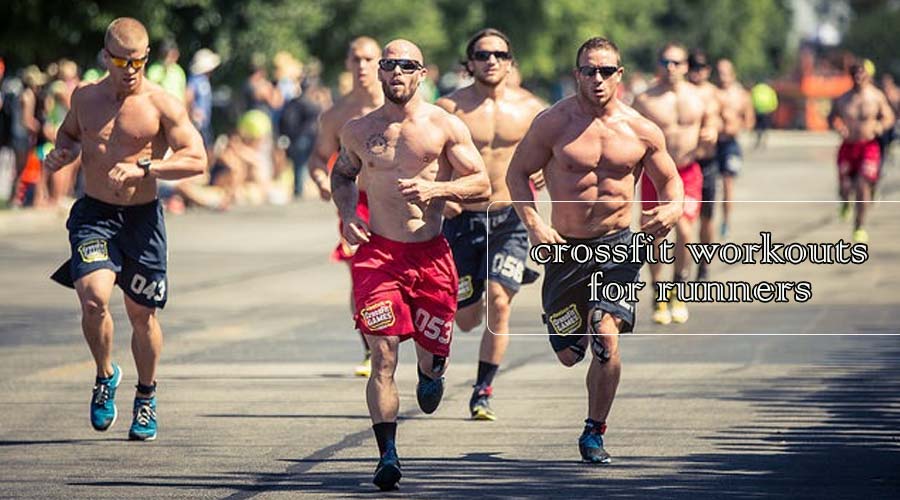Running is one of the most popular forms of exercise, but for those looking to take their performance to the next level, CrossFit workouts specifically tailored for runners offer a great solution. Crossfit is a high-intensity form of exercise that combines strength training, cardiovascular conditioning, and gymnastics elements into an intense workout. By combining running with CrossFit exercises like plyometrics, Olympic lifts, and bodyweight movements, runners can expect to significantly improve their speed and endurance while also increasing muscle mass and stamina.
Crossfit and Running

Crossfit and running have been two of my favorite fitness activities for years. Not only do they both challenge me to push myself further than I ever thought possible, but they also bring balance to my life. Crossfit is an intense workout that relies on constantly varied functional movements. It builds strength, power, speed, and endurance all at once, pushing me out of my comfort zone and allowing me to reach new heights in terms of physical performance. Running is a great way for me to take some time away from the intensity of Crossfit and clear my head while still getting in a good workout. The rhythmic nature helps calm my mind so that I can come back to Crossfit feeling refreshed and ready to tackle any challenge ahead of me.
Benefits of Crossfit: Core Strength
Crossfit has become increasingly popular among runners in recent years as they recognize the many benefits it can bring to their training. Crossfit focuses on core strength, which is essential for any runner looking to improve their performance. A strong core helps to improve balance, stability, and posture while running, all of which are key components of a successful and efficient running technique. Not only that, but Crossfit movements specifically target the muscles used during running such as the glutes, hamstrings, and quads. As these muscles grow stronger through Crossfit workouts they also become more resistant to injury while out on a run.
In addition to increasing muscular strength and endurance, Crossfit can benefit a runner’s flexibility. It includes exercises such as stretching, foam rolling, and mobility drills that help keep soft tissues healthy by improving the range of motion in various muscle groups.
Benefits of Crossfit: Improved Mobility
Crossfit training is one of the best ways for runners to improve their mobility. This type of workout involves a combination of exercises that focus on strengthening specific muscles and joints, as well as increasing overall flexibility. Crossfit can help runners increase their range of motion, which in turn can make them more agile and reduce the risk of injury while running. It also helps with post-run soreness by building up strength and endurance so runners can recover faster.
One major benefit of Crossfit for runners is that it allows them to work out different muscle groups at the same time during an intense workout session. By doing this, they get more out of each session, thus improving their performance as a whole. Different types of exercises like plyometrics or Olympic lifts provide a great way to build power without putting extra stress on the body’s joints. Crossfit can help athletes reach new levels of performance that weren’t previously possible with traditional running training alone.
Benefits of Crossfit: Injury Prevention

CrossFit offers a variety of benefits to runners, particularly in the area of injury prevention. CrossFit provides full-body workouts that improve strength and mobility which helps runners to become more resilient and better able to withstand the rigors of running. By building muscles and tendons through CrossFit exercises, runners can develop improved stability throughout their bodies, reducing their risk for overuse injuries related to running.
CrossFit also teaches proper form for lifting weights, allowing runners to properly strengthen key areas such as their hips, glutes, and core—all fundamental elements for successful running performance. Additionally, CrossFit enhances cardiovascular endurance through its high-intensity interval training (HIIT) circuit-style classes that include exercises like burpees, jump squats, and mountain climbers. These exercises boost anaerobic capacity while helping build greater stamina—both essential components to any runner’s training program.
Types of Crossfit Exercises
Crossfit is a popular exercise program that offers a variety of exercises designed to strengthen the body, improve stamina and increase endurance. For runners who are looking to improve their performance, Crossfit can be an ideal solution. There are several types of Crossfit exercises specifically tailored to meet the needs of runners.
Strength training is one type of Crossfit program for runners. This type of exercise helps build lean muscle and tone existing muscles while increasing strength and stability in areas that will lead to improved running form and performance. Plyometric exercises are another type of Crossfit program that involve quick bursts of movement performed with explosive power which helps develop the fast twitch fibers needed for running speed. Core strengthening exercises such as planks, pull-ups, and lunges help create core stability so runners can maintain proper posture during running events without losing energy or feeling fatigued prematurely.
Sample Workouts
Crossfit workouts for runners are a great way to improve overall fitness and running performance. The constantly varied, high-intensity movements are designed to increase overall strength and speed while also helping to reduce the likelihood of injury. Sample Crossfit workouts can be tailored to every level of runner from beginner up to elite, with exercises focusing on improving coordination, balance, agility, power, speed, and endurance.
Advanced runners will benefit greatly from incorporating weightlifting exercises into their training routines such as deadlifts, squats, and cleans. They should focus on increasing their bodyweight strength in order to maintain muscle mass during distances longer than 5Ks. Additionally, they should do dynamic stretching exercises such as leg swings or jump ropes that help lengthen the muscles while increasing flexibility.
Strength Training

Crossfit workouts for runners have become an increasingly popular way to increase their strength and endurance. Crossfit combines elements of high-intensity interval training, core and strength work, Olympic weightlifting, and gymnastics movements that are designed to build power, speed, and overall fitness. Running can often leave athletes with weak upper bodies and tight muscles. Crossfit offers a unique opportunity to target these areas through movement-based exercises such as squats, deadlifts, presses, chins ups, burpees, box jumps, and more.
By blending cardio bursts with bodyweight exercises in short intervals – usually two minutes or less – runners can condition their muscles for explosive bursts of energy during long-distance races or intense sprints.
Tips for Safety
Crossfit workouts are increasingly popular among runners, as they provide a great way to build strength and endurance while staying motivated. However, any type of routine comes with potential risks if not performed correctly and CrossFit workouts for runners are no exception. Here are some tips to help ensure you stay safe when incorporating CrossFit into your running program.
First, start off slow – it’s important that you ease into CrossFit with the same caution that you would before increasing your mileage or adding another interval workout to your regimen. Spend time perfecting each exercise so that form is correct and avoid pushing too hard too soon in order to avoid injury. Additionally, take extra caution with weight-bearing exercises as sprains can easily occur if done improperly or without control. Second, build a good base – just like with running, CrossFit workouts for runners are best accomplished by first building a solid foundation of strength and endurance. Start with lighter weights and higher reps to build your base then increase the weight and decrease the reps as you become stronger. This will help you avoid injury and also build up your endurance for the challenging workouts that lie ahead. Third, cross-train – as mentioned above, CrossFit for runners is a great way to increase your endurance, speed, and overall fitness. However, it’s not a replacement for things like long-distance running or interval training. To maximize your performance as a runner and avoid injury, you should also be incorporating these other types of workouts into your routine.
Modifications for Injury
Crossfit workouts for runners can be an effective way to maintain physical fitness and health, but there are some modifications that need to be made when the injury is present. Taking the proper precautions when it comes to injuries can help runners stay healthy and avoid further damage.
In order to ensure that an injury does not worsen while doing a Crossfit routine, it is important to modify the movements and intensity of the workout accordingly. For example, if a runner has a knee injury, they should avoid any squatting or jumping exercises as these could cause further inflammation and pain. Instead, they could substitute different movements such as bodyweight lunges or single-leg squats for similar muscle groups with less stress on the joint. Stretching before and after each workout can also help maintain flexibility in areas that may have been affected by injury.
Nutrition Considerations

Crossfit workouts can be an incredibly effective way for runners to build strength and speed. However, if not properly approached, they can also lead to injury and exhaustion. Nutrition considerations while performing Crossfit workouts are essential for runners to ensure that their bodies have enough fuel to meet the demands of these intense training sessions. Protein intake is important as it helps promote muscle growth and repair. Eating a good balance of protein with carbohydrates prior to a Crossfit workout session will ensure sustained energy levels throughout the entire workout. Hydration is also key during Crossfit workouts as sweating can quickly deplete water reserves in the body leading to fatigue, cramping, and long-term health issues. When hydrating during Crossfit workouts, electrolyte drinks are a great option due to their ability to replace minerals lost through sweat while providing a source of energy at the same time.
Incorporating Crossfit into Running Routines
Crossfit has become a popular form of exercise over the past few years, and for good reason. It is an intense workout that combines elements of weightlifting, plyometrics, gymnastics, and aerobic exercises. Many runners have begun incorporating CrossFit into their running routines to add variety to their workouts and challenge themselves more effectively. The benefits of this hybrid approach are numerous; strength training helps build endurance for long-distance running, while the dynamic movements increase coordination and balance which can help improve speed when it comes time to race. Additionally, by introducing new movements such as pull-ups or box jumps into a runner’s routine they can work on problem areas like weak quads or tight calf muscles with targeted exercises.
Frequently Asked Questions (FAQ)
How do Crossfit workouts for runners compare to other running workouts?
Crossfit workouts are high-intensity, full-body exercises designed with the goal of improving fitness levels quickly and effectively. These workouts involve fast-paced circuits that combine movements from a variety of disciplines such as weightlifting, gymnastics, and plyometrics. Additionally, Crossfit exercises focus on building strength in both small muscle groups such as the triceps, and larger muscle groups like the back muscles.
Does CrossFit burn more calories than running?
The main factor to consider is the intensity of each workout. Running can be done at various speeds and distances, while CrossFit usually involves short bursts of high-intensity exercises with minimal rest periods between them. This means that CrossFit often requires more effort than running and can lead to burning more calories in the same amount of time. Additionally, due to its high-intensity nature, it also helps build muscle which can help increase metabolism even after the workout is over.
Can you train for a marathon and do CrossFit?
CrossFit is a high-intensity interval training program that focuses on functional movements like running, rowing, push-ups, and squats. It strengthens your muscles and helps to improve endurance through short bursts of activity followed by rest periods. To prepare for a marathon with CrossFit you will need to focus on increasing mileage each week while supplementing your workouts with long-distance runs or bike rides. Additionally, CrossFit exercises that target the core muscles can help you stay strong throughout your training period so you are best prepared for race day.



